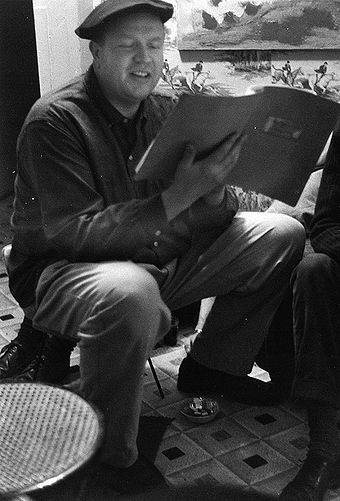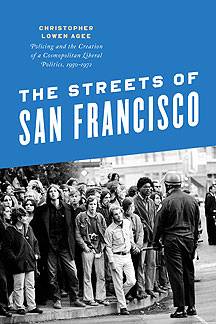Cosmopolitan Liberalism, Harm, and the Profitable Beat Scene
Historical Essay
By Christopher Lowen Agee
Beatnik parade in Union Square, August 13, 1958.
Photo: Bancroft Library
The press highlighted narratives like the Sublette tragedy to raise the alarm over the beats’ suicidal tendencies, but the Sublette storyline also reinforced popular perceptions of the North Beach bohemia as white. Sublette had incited interracial violence when she left the confines of North Beach and naively consorted with black men in another neighborhood. Within the bounds of North Beach, the San Francisco press uncovered evidence only of beats bringing violence upon themselves.
The various articles on beat self-destruction thus carried the possible subtext that for mature people, North Beach could be an exciting but safe environment in which they could find a release from traditional cultural strictures. Following these conclusions, a new generation of white journalists used their coverage of the North Beach beat scene to begin questioning the city leadership’s commitment to traditional family values. Introducing a new, cosmopolitan liberal posture, these young journalists characterized the beats’ rejection of old gender boundaries as harmless and even a boon to the city’s economy.
The tourists streaming into North Beach, Venice Beach, and Greenwich Village revealed that a sizeable segment of the white middle class found beats more entertaining than terrifying. In San Francisco, Gray Line added a bus- tour route for upper Grant Avenue to satisfy the new rush of sightseers pouring into the neighborhood. The nation’s mass culture makers, meanwhile, scrambled to cash in on the fast-spreading beat phenomenon. Some beat-themed productions, such as the film The Beatniks (1960), traded in violence and sexual degradation, but Atlantic Records associated the scene with fun and excitement when it proclaimed itself “the label in tune with the beat generation.” Similarly, television shows such as The Many Loves of Dobie Gillis and films like The Subterraneans (1960) relayed comedic or sympathetic representations of beat culture.(28)
The effusion of national interest inspired some liberals to suggest that the beats buttressed the neighborhood’s reputation as cosmopolitan and economically productive. One North Beach resident rejoiced that the beats provided his neighborhood with a “prestige” similar to that of New York’s Greenwich Village, and he noted that very few of the patrons flowing into “Grant Street [sic] establishments could be called bums.” A San Francisco film critic lauded The Subterraneans—an otherwise almost universally panned movie—as “a visually exciting picture” that offered “jeweled night views” of the bustling city.(29) This excitement over the economic possibilities of beat neighborhoods extended beyond major beat centers like San Francisco and New York City. In St. Louis, for instance, the Globe-Democrat and the Post-Dispatch celebrated their city’s bohemian Gaslight District under the headlines “Homeland of the Individualists” and “Rehabilitation in Gaslight.”(30)
Eric "Big Daddy" Nord, c. 1958
Photo: C.R. Snyder
In San Francisco the emerging cosmopolitan liberal appreciation for North Beach was clearest in the press’s reports on Eric Nord, a North Beach entertainment entrepreneur. Charismatic, red-bearded, and “gargantuan,” Nord had worked on and off in the North Beach nightlife scene since the late 1940s. He was a master of gossip-column self-promotion, and Herb Caen proclaimed him “The King of North Beach.” In January 1958, Nord began promoting a beat Party Pad and established himself as a beat scene spokesperson in the press. Recalling Nord’s celebrity, the poet Meltzer described the entrepreneur:
Eric was, you know, a very larger-than-life figure and was getting just a lot of publicity for being this big, Falstafian guy with babes on each knee looking, you know, looking like stuff on a car, you know like hood ornaments. Because he was large: tall and wide, and just generally like a very avuncular sort of guy. And he was cashing in too.(31)
Through Nord, cosmopolitan liberals illustrated how North Beach’s rejection of family values opened sexual and entrepreneurial possibilities for white, heterosexual men. That message paralleled the urban-oriented challenges to traditional family values being mounted in national publications like Playboy. During the 1950s, Playboy became a sensation by encouraging men to abandon the family responsibilities of suburbia for a life of sexual and consumerist hedonism in the city. However, the magazine’s editors regarded the beats as pathetic because, in their estimation, the bohemians had unchained themselves from the supposed shackles of marriage only to waste that freedom in sexless poverty. Nord’s entrepreneurial promiscuous lifestyle served as a sharp counterpoint to Playboy’s stereotype of the beats. As Nord proved he could use the beat scene to rake in tourist dollars and young white women, local cosmopolitan liberal reporters began using Nord’s legal transgressions to offer amused and unworried descriptions of beat gender-role bending. In the late summer of 1958, for instance, Nord was caught absconding out of town with two white, high school–aged girls. Even before the girls resurfaced—apparently unharmed—cosmopolitan liberal journalists reported on Nord’s actions as a titillating but harmless joke. Through their reports on Nord’s various run-ins with police, sometimes presented in the newspapers’ entertainment sections, cosmopolitan liberal reporters raised the possibility that the beat scene offered enterprising white men financial profit and heterosexual excitement.(32)
From the start, the cosmopolitan liberal perspective on North Beach assumed that one could be in the scene without being of it. The new brand of liberals drew this distinction by differentiating between “hardcore beats” and “weekend beats.” Cynthia Grey, advice columnist for the San Francisco News, referenced these two categories in July 1958 when a mother identified as “Upset” wrote her anxiously, “I think my daughter is becoming a beatnik.” Upset’s daughter had refused to join the family on vacation and had instead spent her college break associating with bearded men. Grey was unruffled.
“For one,” the columnist chided, “stop worrying. Chances are your daughter is merely a ‘Sunday Beatnik’ which is quite different from a full-time Beatnik who is a permanent parasite rejecting life’s responsibilities.” Grey suggested that the daughter would leave the beats behind once the school year began, but that Upset could accelerate this process by withholding the daughter’s car and allowance.(33)
Cosmopolitan liberals often delivered their unperturbed reactions to the beats as jokes, but their new approach to cultural pluralism represented the early stages of a seismic shift in liberal conceptions of crime. During the mid- and late 1950s, liberals in the United States and Western Europe began breaking away from old definitions of law by turning to the so-called harm principle. The postwar harm principle, based on the mid-nineteenth-century writings of John Stuart Mill, viewed the state as justified in policing only activities that physically or materially injured others.(34)
Across the country, cosmopolitan liberals used the policing of beats to issue harm-principle critiques of moralistic law enforcement. In 1959, Philadelphia’s Evening Bulletin mocked Captain Frank Rizzo’s raid of a beat bar by pointing out that the police raid had been motivated by “Beards! Turtle neck sweaters! Tights! People sitting around and talking.” Evening Bulletin readers then flooded the newspaper with letters to the editor charging that Rizzo’s policing of culture distracted law enforcement from harmful crimes that merited police attention. Separate letters decried the policing of the beats by pointing to the “muggings,” the “cut-throat hoods,” the “crimes of violence,” and “all the murders, holdups and rackets in the City.”(35)
Regarding beat behavior as harmless, other cosmopolitan liberals suggested that police repression of the beats warranted defiance. In the spring of 1958, Caen began patronizing the Coffee Gallery, and his columns soon addressed SFPD harassment. One Caen dispatch began:
Fri., two cops stalked into the Bagel Shop on Grant Ave. and announced to the assembled Beatniks: “Awright, we’re gonna vag (charge with vagrancy) anybody who can’t prove employment.” This was greeted with such a roar of laughter that the cops wavered, fell back, broke ranks, fled in vagrant confusion. Having sniffed along Beat Blvd. recently. . . . I think fragrancy might be a more reasonable charge.
Caen denigrated the beats as smelly, ridiculous “Beatniks,” but then used this characterization to describe the beat rejection of police authority as innocuous and even funny.(36)
Notes
28. Rigney and Smith, Real Bohemia, 161; Watson, Birth of the Beat Generation, 260, 4. Similarly, some members of the judiciary failed to express alarm over beat defendants. On July 22, for instance, a municipal judge issued an injunction against the police department's harassment of Eric Nord's Party Pad. SAN FRANCISCO CHRONICLE, July 23, 1958, 30. Playboy meanwhile traded its earlier depiction of beat women as frigid with an alluring "Beat Playmate." "Playboy's Beat Playmate," Playboy, July 1959, 47. Also see Paul O'Neil, "The Only Rebellion Around," Life, November 30, 1959, 116.
29. LITTLE CITY NEWS, June 11,1958, 3; SAN FRANCISCO NEWS-CALL-BULLETIN, June 24, 1960, 21.
30. Danny Kathiner, "The Rise and Fall of Gaslight Square," Gateway Heritage: The Magazine of the Missouri Historical Society 22, no. 2 (2001): 42.
31. SAN FRANCISCO NEWS, August 9, 1958,1; Morgan, Beat Generation, 36; Meltzer interview.
32. Constitutional Rights hearings of 1958, 158. SAN FRANCISCO CHRONICLE, August 19, 1958, 3; August 12, 1958, 5; December 27, 1958, 2; July 23, 1958, 30. SAN FRANCISCO EXAMINER, August 11, 1958, 1. SAN FRANCISCO NEWS, August 9, 1958, 1.
33. SAN FRANCISCO NEWS, July 29, 1958, 6. Brown approvingly explained that upper Grant Avenue provided gay men with a healthy place for them to become weekend beats and "find conformity for their non-conformity." SAN FRANCISCO EXAMINER AND CHRONICLE, June 22, 1958, TW6.
34• Bernard Harcourt, Illusion of Order: The False Promise of Broken Windows Policing (Cambridge, MA: Harvard University Press, 2001), chapter 7.
35. Evening Bulletin (Philadelphia), February 18, 1959, 1; February 19, 1959, 14. Also see Marc Stein, City of Sisterly and Brotherly Loves: Lesbian and Gay Philadelphia, 1945-1972 (Chicago: University of Chicago Press, 2000),160.
36. LITTLE CITY NEWS, April 16, 1958, 3; SAN FRANCISCO CHRONICLE, May 13,1958, 17.
Reprinted with permission from The Streets of San Francisco: Policing and the Creation of a Cosmopolitan Liberal Politics, 1950-1972 by Christopher Lowen Agee, published by the University of Chicago Press. © 2014 by The University of Chicago. All rights reserved.



